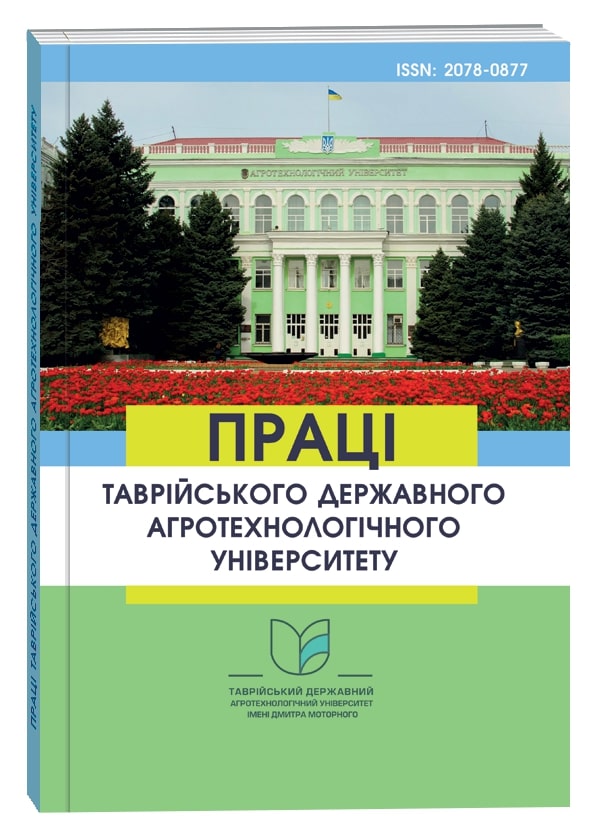ПІДВИЩЕННЯ ЕФЕКТИВНОСТІ ПРОТОЧНИХ ЧАСТИН СОПЛОВИХ ПРИСТРОЇВ ПНЕВМАТИЧНИХ СИСТЕМ НА ОСНОВІ ПОГЛИБЛЕНОГО ДОСЛІДЖЕННЯ РОБОЧОГО ПРОЦЕСУ
Анотація
Процес дроселювання газу використовується в багатьох технічних пристроях, зокрема в ущільнювальній техніці, пневмоабразивних установках, вимірювальних приладах, в сепараційних пристроях і т.д. Дроселем може вважатися будь який пристрій, який створює суттєву перешкоду течії робочого потоку, такий як звужений отвір, сопло, пориста перегородка, діафрагма, клапан, вентиль тощо. Пропускаючи робочий потік через дросель, можемо досягти необхідної зміни його газодинамічних параметрів. Ефект дроселювання робочого потоку використовується в лабіринтних та інших безконтактних ущільненнях. Одним з основних показників ефективності ущільнювальної техніки є коефіцієнт витрати щілини. Течія через лабіринтне ущільнення побудована по аналогії через ряд послідовно встановлених соплових пристроїв, які створюють ряд перешкод. Оцінювати ефективність роботи сопла можна також за коефіцієнтом його витрати. На значення коефіцієнта витрати будь якого пристрою впливають особливості робочого процесу, отже впливаючи потрібним чином на геометрію проточної частини можливе підвищення ефективності ущільнень та сопел в широкому діапазоні режимних параметрів. Вдосконалити ущільнення означає зменшити його пропускну здатність, а вдосконалити сопло пневмоабразивної установки – отримати максимально можливе значення витрати робочого середовища та його швидкості на виході. На основі виконаних досліджень робочого процесу встановлено вплив геометричних та режимних параметрів на характеристики соплових пристроїв, що працюють на стисненому повітрі, та на повітряно-абразивній суміші, що дало можливість підвищите ефективність соплових пристроїв.
Посилання
2. Arana-Landín G., Uriarte-Gallastegi N., Landeta-Manzano B., Laskurain-Iturbe I. The contribution of lean Management—Industry 4.0 technologies to improving energy efficiency. Energies. 2023. Vol. 16(5). P. 2124. https://doi.org/10.3390/en16052124.
3. Kotliar A., Basova Y, Ivanov V., Murzabulatova O., Vasyltsova S., Litvynenko M., Zinchenko O. Ensuring the economic efficiency of enterprises by multi-criteria selection of the optimal manufacturing process. Management and Production Engineering Review. 2020. Vol. 11(1). P. 52–61. https://doi.org/10.24425/mper.2020.132943.
4. Rudawska A., Danczak I., Müller M., Valasek P. The effect of sandblasting on surface properties for adhesion. International Journal of Adhesion and Adhesives. 2016. Vol. 70. P. 176–190. https://doi.org/ 10.1016/j.ijadhadh.2016.06.010.
5. Peñuela-Cruz C. E., Márquez-Herrera A., Aguilera-Gómez E., Saldaña-Robles A., Mis- Fernández R., Peña J. L., Caballero-Briones F., Loeza-Poot M., Hernández-Rodríguez E. The effects of sandblasting on the surface properties of magnesium sheets: a statistical study. Journal of Materials Research and Technology. 2023. Vol. 23. P. 1321–1331. https://doi.org/10.1016/j.jmrt.2023.01.117.
6. Pruszczyńska E., Pietnicki K., Klimek L. Effect of the abrasive blasting treatment on the quality of the pressed ceramics joint for a metal foundation. Archives of Materials Science and Engineering. 2016. Vol. 78(1). P. 17–22. https://doi.org/10.5604/18972764.1226310.
7. Ahmed F., Chen W. Investigation of steam ejector parameters under three optimization algorithm using ANN. Applied Thermal Engineering. 2023. Vol. 225. e120205. https://doi.org/10.1016/j.applthermaleng. 2023.120205.
8. Van den Berghe J., Dias B. R. B., Bartosiewicz Y., Mendez M. A. A 1D model for the unsteady gas dynamics of ejectors. Energy. 2023. Vol. P. 267. https://doi.org/10.1016/j.energy.2022.126551.
9. Yan J., Li Z., Zhang H. Investigation on key geometries optimization and effect of variable operating conditions of a transcritical R744 two-phase ejector. Applied Thermal Engineering. 2023. Vol. 230. e120733. https://doi.org/10.1016/j.applthermaleng.2023.120733.
10. Xu Y., Li Q., Li B., Guan Z. Numerical simulation study of hydraulic fracturing nozzle erosion in deep well. Frontiers in Physics. 2022. Vol. 10. e947094. https://doi.org/10.3389/fphy.2022.947094.
11. Li A., Chen J., Xi G., Huang Z. Numerical investigation of the effect of primary nozzle geometries on flow structure and ejector performance for optimal design. Journal of Mechanical Science and Technology. 2023. Vol. 37(5). P. 2139–2148. https://doi.org/10.1007/ s12206-023-2101-2.
12. Aronson K. E., Ryabchikov A.Y., Zhelonkin N. V., Brezgin D. V., Demidov A. L., Balakin D. Y. Features of the development and operation of multistage steam jet ejectors. Thermal Engineering. 2023. Vol. 70(4). P. 245–253. https://doi.org/10.1134/S0040601523040018.
13. Bañon F., Sambruno A., Batista M., Simonet B., Salguero J. Surface quality and free energy evaluation of S275 steel by shot blasting, abrasive water jet texturing and laser surface texturing. Metals. 2020. Vol. 10(2). P. 290. https://doi.org/10.3390/met10020290.
14. Kwon D.-K., Lee J.-H. Performance improvement of micro-abrasive jet blasting process for al 6061. Processes. 2022. Vol. 10(11). P. 2247. https://doi.org/10.3390/pr10112247.
15. Sychuk V., Zabolotnyi O., McMillan A. Developing new design and investigating porous nozzles for abrasive jet machine. Powder Metallurgy and Metal Ceramics. 2015. Vol. 53(9-10). P. 600–605. https://doi.org/10.1007/s11106-015- 9655-1.
16. Hao X., Yan J., Gao N., Volovyk O., Zhou Y., Chen G. Experimental investigation of an improved ejector with optimal flow profile. Case Studies in Thermal Engineering. 2023. Vol. 47. e103089. https://doi.org/10.1016/j.csite.2023.103089.
17. Kartal V., Emiroglu M. E. Effect of nozzle type on local scour in water jets: An experimental study. Ocean Engineering. 2023. Vol. 277. e114323. https://doi.org/10.1016/j.oceaneng.2023.114323.
18. Xi X., Xin Y., Duan D., Zhang B. Experimental investigation on the performance of a novel resonance-assisted ejector under low pressurization. Energy Conversion and Management. 2023. Vol. 280. e116778. https://doi.org/10.1016/j.enconman.2023.116778.
19. Han X., Xiao J., Yu F., Zhao W. Relationships and mechanisms of sand grain promotion on nozzle cavitation flow evolution: A numerical simulation investigation. Journal of Thermal Science. 2022. Vol. 31(6). P. 2385–2410. https://doi.org/10.1007/s11630-022-1568-y.
20. Fesenko A., Yevsiukova F., Basova Y., Ivanova M., Ivanov V. Prospects of using hydrodynamic cavitation for enhancement of efficiency of fluid working medium preparation technologies. Periodica Polytechnica Mechanical Engineering. 2018. Vol. 62(4). P. 269–276. https://doi.org/ 10.3311/PPme.11877.
21. Zabolotnyi O., Povstyanoy O., Somov D., Sychuk V., Svirzhevskyi K. Technology of Obtaining Long-Length Powder Permeable Materials with Uniform Density Distributions. World Congress on Engineering and Technology: Innovation and its Sustainability 2018. WCETIS 2018. 2022. Ch. 3. P. 63–78. https://doi.org/10.1007/978-3-030-20904-9_5.
22. Somov D., Zabolotnyi O., Polinkevich R., Valetskyi B., Sychuk V. Experimental Vibrating Complex for the Research of Pressing Processes of Powder Materials. Advances in Design, Simulation and Manufacturing II. DSMIE 2019. Lecture Notes in Mechanical Engineering. 2020. Ch. 3. P. 321–329. https://doi.org/10.1007/978-3-030-22365-6_32.
23. Zabolotnyi O., Sychuk V., Somov D. Obtaining of Porous Powder Materials by Radial Pressing Method. In: Ivanov, V., et al. Advances in Design, Simulation and Manufacturing. DSMIE 2018. Lecture Notes in Mechanical Engineering 2019. Springer, Cham, pp. 186–198. DOI: 10.1007/978-3-319-93587-4_20 Energies 2023, 16, x FOR PEER REVIEW 15 of 16
24. Sychuk V., Zabolotnyi O., Somov D. Technology of Effective Abrasive Jet Machining of Parts Surfaces. Advances in Design, Simulation and Manufacturing. DSMIE 2018. Lecture Notes in Mechanical Engineering. 2019. Ch. 1. P. 166–176. https://doi.org/10.1007/978-3-319-93587-4_18.
25. Povstyanoi O. Y., Sychuk V. A., McMillan A., Rud’ V. D., Zabolotnyi O. V. Metallographic analysis and microstructural image processing of sandblasting nozzles produced by powder metallurgy methods. Powder Metallurgy and Metal Ceramics. 2015. Vol. 54(3-4). P. 234–240. https://doi.org/10.1007/s11106-015-9705-8.
26. Bondarenko G., Baga V., Bashlak I. Flow simulation in a labyrinth seal. Applied Mechanics and Materials. 2014. Vol. 630. P. 234–239. https://doi.org/10.4028/www.scientific.net/AMM.630.234.
27. Merzliakov I., Pavlenko I., Chekh O., Sharapov S., Ivanov V. Mathematical modeling of operating process and technological features for designing the vortex type liquid-vapor jet apparatus. Advances in Design, Simulation and Manufacturing II. DSMIE 2019. Lecture Notes in Mechanical Engineering. 2020. Ch. 3. P. 613–622. https://doi.org/ 10.1007/978-3-030-22365-6_61.
28. Merzliakov I., Pavlenko I., Ochowiak M., Ivanov V., Agarwal P. Flow modeling in a vortex chamber of a liquid–steam jet apparatus. Processes. 2022. Vol. 10(5). P. 984. https://doi.org/10.3390/pr10050984.



